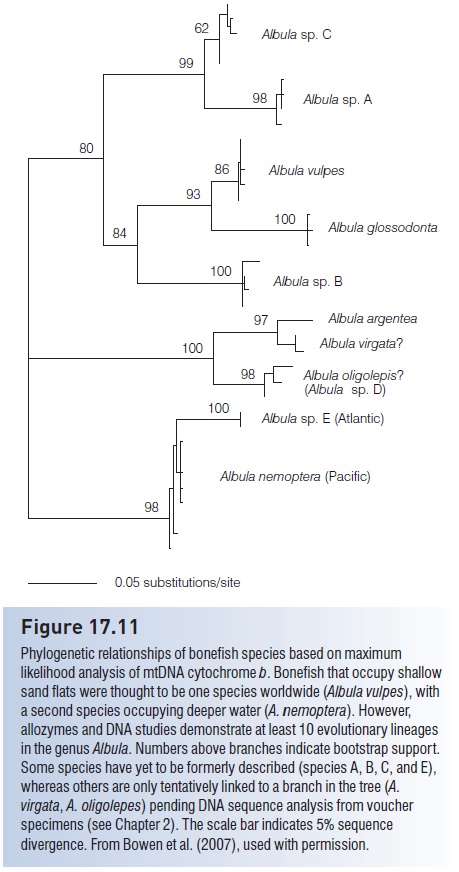Chapter: The Diversity of Fishes: Biology, Evolution, and Ecology: Fish genetics
Cryptic evolutionary diversity: the case of the bonefishes
Cryptic evolutionary diversity: the case of the bonefishes
Bonefishes (genus Albula) inhabit sand flats in tropical and subtopical habitats, where they are widely sought by anglers because of their high-energy battles at the end of a fishing line. The bonefish was originally described by Linnaeus (1758). Subsequent taxonomic research contributed 23 species names for bonefishes around the world. However as scientific communication improved in the 19th and 20th century, it became apparent that these regional “species” were very similar or indistinguishable. These species weresynonymized until most bonefish were recognized as a single species (Whitehead 1986).
The recognition of a single globally distributed bonefish began to unravel when Shaklee and Tamaru (1981) analyzed allozymes in Hawaiian bonefish. They discovered two genetically distinct forms that occupy similar habitats, and that only could be distinguished by careful examination of jaw structure. Subsequent comparisons with mtDNA cytochrome b revealed ancient genetic separations in the genus Albula (d =0.03–0.30), indicating three species in the Caribbean, and three in the East Pacific (Pfeiler et al. 2006; Bowen et al. 2007). Hidaka et al. (2008) discovered subtle morphological differences among Pacific bonefishes, and split one widespread Pacific species into three regional species: A. virgata (a Hawaiian endemic), A. argentea (distributed from the central to West Pacific), and A. oligolepis (West Pacific to Africa). At this writing, there are probably 10 bonefish species, although several have not been formally described (Fig. 17.11). The deepest genetic separation in the genus is between the two sympatric Pacific species A. glossadonta and A. argentea, with an mtDNA cytochrome b sequence divergence of d =0.26–0.30. Based on a molecular clock calibrated for bonefish cytochrome b (1%/Ma), this corresponds to 26–30 million years. It is a remarkable finding that these two fishes, which are identical to the untrained eye and were considered a single species until recently, are five times older than the separation of gorillas and humans.

Related Topics